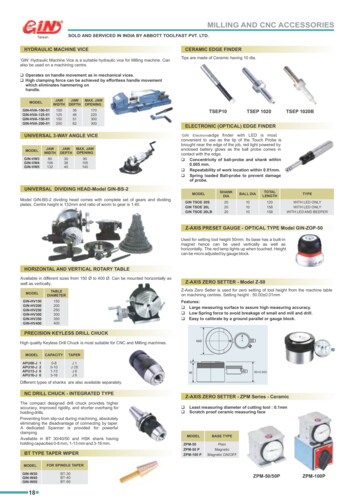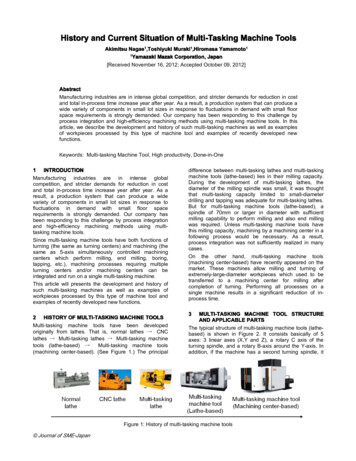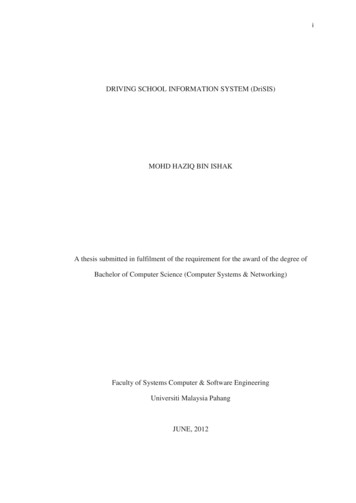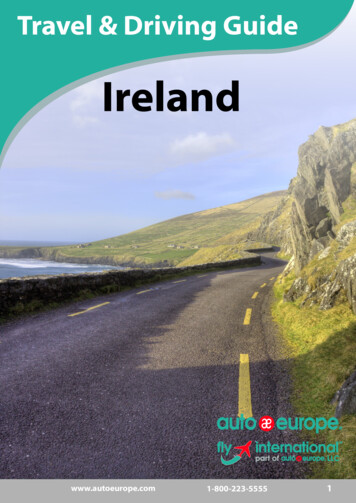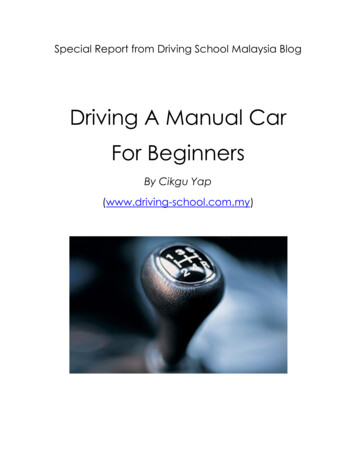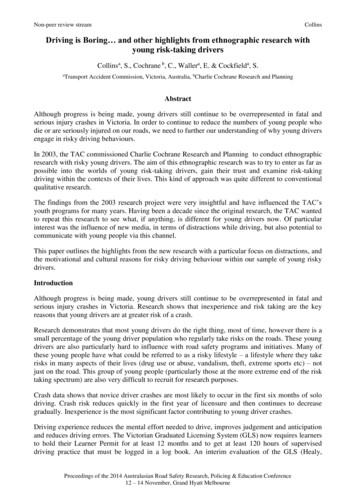
Transcription
Non-peer review streamCollinsDriving is Boring and other highlights from ethnographic research withyoung risk-taking driversCollinsa, S., Cochrane b, C., Wallera, E. & Cockfielda, S.aTransport Accident Commission, Victoria, Australia, bCharlie Cochrane Research and PlanningAbstractAlthough progress is being made, young drivers still continue to be overrepresented in fatal andserious injury crashes in Victoria. In order to continue to reduce the numbers of young people whodie or are seriously injured on our roads, we need to further our understanding of why young driversengage in risky driving behaviours.In 2003, the TAC commissioned Charlie Cochrane Research and Planning to conduct ethnographicresearch with risky young drivers. The aim of this ethnographic research was to try to enter as far aspossible into the worlds of young risk-taking drivers, gain their trust and examine risk-takingdriving within the contexts of their lives. This kind of approach was quite different to conventionalqualitative research.The findings from the 2003 research project were very insightful and have influenced the TAC’syouth programs for many years. Having been a decade since the original research, the TAC wantedto repeat this research to see what, if anything, is different for young drivers now. Of particularinterest was the influence of new media, in terms of distractions while driving, but also potential tocommunicate with young people via this channel.This paper outlines the highlights from the new research with a particular focus on distractions, andthe motivational and cultural reasons for risky driving behaviour within our sample of young riskydrivers.IntroductionAlthough progress is being made, young drivers still continue to be overrepresented in fatal andserious injury crashes in Victoria. Research shows that inexperience and risk taking are the keyreasons that young drivers are at greater risk of a crash.Research demonstrates that most young drivers do the right thing, most of time, however there is asmall percentage of the young driver population who regularly take risks on the roads. These youngdrivers are also particularly hard to influence with road safety programs and initiatives. Many ofthese young people have what could be referred to as a risky lifestyle – a lifestyle where they takerisks in many aspects of their lives (drug use or abuse, vandalism, theft, extreme sports etc) – notjust on the road. This group of young people (particularly those at the more extreme end of the risktaking spectrum) are also very difficult to recruit for research purposes.Crash data shows that novice driver crashes are most likely to occur in the first six months of solodriving. Crash risk reduces quickly in the first year of licensure and then continues to decreasegradually. Inexperience is the most significant factor contributing to young driver crashes.Driving experience reduces the mental effort needed to drive, improves judgement and anticipationand reduces driving errors. The Victorian Graduated Licensing System (GLS) now requires learnersto hold their Learner Permit for at least 12 months and to get at least 120 hours of superviseddriving practice that must be logged in a log book. An interim evaluation of the GLS (Healy,Proceedings of the 2014 Australasian Road Safety Research, Policing & Education Conference12 – 14 November, Grand Hyatt Melbourne
Non-peer review streamCollinsCatchpole, & Harrison, 2012) has demonstrated positive outcomes for young drivers (27%reduction in casualty crashes of first year drivers).Risky driving behaviour can be intentional or unintentional. Unintentional risk taking is probablyrelated to inexperience and/or lack of recognition that their driving behaviour is risky. However,knowing that driving behaviour is risky, doesn’t necessarily mean that a young driver will stopengaging in that behaviour. Young drivers tend to underestimate the likelihood that they will crash,and at the same time overestimate their driving ability.Australian Institute of Family Studies research (Vasallo et al., 2007), that studied a cohort of over1000 young people in Victoria from birth, indicates that of the population of young peoplesurveyed, around 7% were high risk drivers, 29% were moderately risky and 64% were low risk.To discourage risk taking behaviour, such as speeding, drink driving or mobile phone useprobationary drivers can only accumulate 5 demerit points before having their licence suspended.They must also have a good driving record to move from one phase to the next. There are alsoseveral specific restrictions for P Platers. In order to continue to reduce the numbers of youngpeople who die or are seriously injured on our roads, we need to further our understanding of whyyoung drivers engage in risky driving behaviours.Risk Taking BehaviourExisting research (Organisation for Economic Co-operation and Development, 2006) demonstratesthat there are a number of factors that underlie the intentionally risky driving behaviour of youngpeople:Biological FactorsNeurobiology research has shown that the specific wiring of each individual’s brain is causal tobehaviour output. Brain development research has found that beyond the age of 18, the human brainis still developing, especially those areas in the frontal lobe that deal with “executive functions” likeplanning, impulse control, reasoning and the integration of information. More recent research hasalso found that the parts of the brain thought to be responsible for social cues and rewardrecognition develop early in adolescence. It appears that there may be a maturational imbalance inthe brain during late adolescence and early adulthood which may make young people more likely totake risks.Essentially, risk taking is a normal part of human development; however, there are individualdifferences in the level of risk taking and this may be where the opportunities for intervention lie.GenderIt is clear that young male drivers’ risk levels are much higher than those of young females, evenwhen exposure is taken into account. Men tend to drive more than women, and women are morelikely to be more safety-oriented than men. Men also tend to drive more for leisure.PersonalityThe personality traits of extraversion, low conscientiousness and low agreeableness have beenfound to be related to high crash involvement. Sensation seeking is another trait that has been foundto be related to crash risk. Several other traits have also been linked to risky driving: mild socialdeviance, hostility, aggression, impulsiveness, emotional liability, locus of control, antisocialmotivation and low altruism.Proceedings of the 2014 Australasian Road Safety Research, Policing & Education Conference12 – 14 November, Grand Hyatt Melbourne
Non-peer review streamCollinsOverall there is a relatively weak, but consistent, relationship between personality traits and crashinvolvement, but a relatively strong relationship between personality traits and the propensity tocommit driving violations.Social NormsImportant influences on behaviour are “subjective norms”, which refer to norms that are believed toexist in the social environment, among people who are closely associated. These may also bereinforced by popular culture. Peers and parents are a key influence on social norms. Norms may beinjunctive or descriptive. Injunctive norms are people’s perceptions of what behaviours areapproved or disapproved of by others, and descriptive norms are people’s perceptions of howpeople actually behave.Ethnographic Research 2003In 2003 the TAC commissioned Charlie Cochrane Research and Planning (CCRP) (CharlieCochrane Research and Planning, 2003) to conduct exploratory research with young risk-takingdrivers.The aim of this ethnographic research was to try to enter as far as possible into the worlds of youngrisk-taking drivers, gain their trust and examine risk-taking driving within the contexts of their lives.This kind of approach was quite different to conventional research. Where data analytics,quantitative surveys and even traditional qualitative research debriefs provide flattened snapshots,ethnography seeks to generate a more empathic understanding of consumers – their lives, theirvalues and how they live, work and play. Clifford Geertz coined the term ‘thick descriptions’ todescribe the way ethnography tries to paint a vivid picture, to tell stories, that help clients andcommunicators make the empathetic leap to see how their consumers see the world, to understandtheir needs, drivers and behaviours.The potency of storytelling in the social marketing context is based around the idea that stories arebaked into the way we humans think and make sense of the world. Our brains don't handle statisticswell, but they do like real stories, stories about people. Daniel Kahneman in his bestseller ThinkingFast and Slow demonstrates that humans often believe individual stories in favour of statistics to thecontrary. Government and business environments are often dominated by the analytic and theintellectual: PowerPoint charts, tables of data and even academic papers like this. Stories engagepeople in a different way: surprising them, making them think, challenging their pre-conceptionsand importantly giving people a new shared language for talking about their customers and users.This is particularly powerful when we are trying to engage with a target group (young risk-takingdrivers) who see the world quite differently from how we do.CCRP conducted 8 in depth video interviews with 18-20 year old male drivers, 4 mini-peer-groupswith 16-20 year old L and P-platers and 2 groups with passengers. All had been involved with risktaking driving and were considered mid-range risk takers (not just a one off, but nothabitual/lifestyle choice). Participants were from inner Melbourne, outer Melbourne and Shepparton(regional area) and surrounds. All participants were male except one of the passenger groups.This research demonstrated that:1. For young people, risk taking is a normal part of driving (and life in general). Demonisingrisk-taking is unhelpful2. There is no magic bullet3. Authoritative “finger wagging” approaches are rejected4. Shock messages are often rejectedProceedings of the 2014 Australasian Road Safety Research, Policing & Education Conference12 – 14 November, Grand Hyatt Melbourne
Non-peer review streamCollins5. Risky driving for its own sake is motivated by factors such as adrenaline, fun, boredom,bravado and competitiveness6. Exacerbating factors include peer pressure, the excitement of the moment, a sense ofinvincibility and a tendency to dismiss serious consequences.7. Of the communication routes explored the area of “mates” and “taking responsibility foryour mates” was the most fertile.8. Communications need to be real/authentic9. There is a need to hear the message in a fresh way, to provoke reassessment; need toleverage several different angles.The findings from this research helped to inform several of the TAC’s youth public educationcampaigns and initiatives. In particular, the Make a Film. Make a Difference. (MAFMAD) shortfilm competition had the key message “Your mates life is in your hands” and allowed young peopleto create communications for other young people. The research also informed our Vanessa programwhich is well accepted and used by young Victorians at major events, such as music festivals.Vanessa is a large truck, fitted out with interactive activities and lots of free merchandise. However,the main purpose is to provide free breath testing for event patrons. The Vanessa staff are young,and are trained to interact with patrons to spread road safety messages in a non-authoritative way.Vanessa program has also expanded to include two other vehicles, a Van that can attend smallerevents and a Ute which attends more regional and light commercial appropriate events. These twovehicles are also 5 star safety rated and help to spread vehicle safety messages.Ethnographic Research 2013In 2013 it was time to review our youth risk taking public education, particularly MAFMAD, andgiven the value obtained from the previous in-depth research, it was identified that conductingsimilar research again would be useful. It was also identified that a new area of interest, that didn’teven exist when the original research was conducted, was the role of mobile phones and other newmedia, especially smart phones. Of interest was the role that smart phones may play as a distractionwhile driving but also the potential to communicate with young people via digital, social and newmedia.CCRP (Charlie Cochrane Research and Planning, 2013) was commissioned to conduct the updatedethnographic research.MethodQualitative research typically sources subjects from a list of people who have signed up as willingto participate in focus groups. These subjects are typically mainstream and there may also be someself-selection bias; for this ethnographic research it was important to source non-traditionalparticipants and a variety of non-traditional recruitment methods were used to reach suitablesubjects. CCRP found a pool of possible subjects through snowballing – friends of friends offriends, through contacts at youth clubs, via lawyers acting for clients, through sporting clubs andnetworks of non-traditional sports, through contacts in the music and club scene etc. as well asthrough names of repeat offenders sourced from the TAC. Initial contact was typically madethrough Facebook by a researcher who was in the same age-group as our target. To maximise thechance of positive engagement, to build trust and understanding it was vital that this initial contactfelt natural and matched participants’ normal modes of communication. Through this initial contactand via phone conversations CCRP explored the lifestyles, risk taking and driving behaviours ofthese subjects and matched those to the demographic and regional framework of who we needed tocover. Because ethnography is so concerned with telling stories we looked for different stories,different kinds of risk-taking and a spectrum of attitudes and behaviours across our sample. Over aProceedings of the 2014 Australasian Road Safety Research, Policing & Education Conference12 – 14 November, Grand Hyatt Melbourne
Non-peer review streamCollinsperiod of weeks CCRP built trust with these participants, explaining to them the process and whatthe research would be used for and reassuring them that they would not be pursued or to get intotrouble for admitting to illegal activities or driving behaviours.See Table 1 for sample spread.Table 1. Research Participants by Age, Location and SexMale 18-21Male 22-25Non-metroRhys 21, BallaratMick 25, KilmoreShelley 22, WallanFemale 22-25Mixed AffinityGroup 18-21Mixed AffinityGroup 22-25Mariko 21, Warburton &fiends Shane and BronnieByron 24, Ballarat &friends Teesh and RhysOuter-suburbsHugh 19, NewportAlex 19, Mont Albert &friends Callum andMartinAndrew 24, WyndhamValeTory 19, PakenhamInner-subsAlex 19, FootscrayTom 24, Kensington &BillMaddy 19 Williamstown& friends Victoria andEllenEllen 24, Albert Park &friends Emily and Will.The primary data collection method was filmed, immersion interviews/observations in the homes ofparticipants plus filmed drives and observation of out of home leisure activities. These immersionswere supplemented with online driving diaries over two weeks and self-recording of driving usingsmartphones or mini video cameras which were provided. Follow up observations were conductedwhich included a review of the self-recorded driving footage.DiscussionOverall, the findings listed earlier from the 2003 research were confirmed to still hold true foryoung people. However, the 2013 research also broadened and contemporised our learnings. In2013 the research participants also included female risk taking drivers. CCRP spent longer with theparticipants, with more warm up and follow up allowing a deeper understanding of their lives andperspectives. The participants in 2003 tended to be stereotypical “hoons”, whereas the 2013participants provided a more diverse group of risk-takers with a greater variety of risks. The 2013research also allowed exploration of new media. See below an outline of some of the new findingsfrom the current research.HoonsAlthough the behaviour of the 2013 participants was quite risky, they didn’t tend to see themselvesas “hoons”. They tended to see their motivations as playful, rather than rebellious or aggressive.They also seemed to distance themselves from typical “hoons” and saw that kind of behaviour asbelonging to someone else. “Hoon” is seen as a pejorative applied to other people who aredisapproved of and distancing themselves from the term and the behaviour may help in some way tojustify their risk-taking.SpeedingParticipants reported feeling as though speed limits are too slow; they know the limits and they liketo push them. There was a sense of impatience, especially with other slow/bad drivers that were inProceedings of the 2014 Australasian Road Safety Research, Policing & Education Conference12 – 14 November, Grand Hyatt Melbourne
Non-peer review streamCollinstheir way as well as with congestion. Low level speeding was not seen by the young people as bador wrong behaviour; everyone else is doing it. In line with other research, the participants felt asthough they were better than older drivers; they are at the peak of their physical abilities, morephysically capable and have faster reactions. They naturally think they can do everythingbetter/faster, including driving.Additionally, impatience may be a product of today’s society and our expectation that everythinghappens quickly. A quote from Genevieve Bell, an anthropologist for Intel, sums it up nicely:“I think we all have a very different sense of time from what we did, say 10 years ago. Therehas been a collapsing of time in terms of people’s expectations for how long things shouldtake. You know, how long is too long. How long before you think ‘why haven’t they gotback to me’. How long before you’re tapping your feet thinking ‘why hasn’t thisdownloaded’, why hasn’t that updated’.”For young people, who have grown up with technology and may adapt to it quicker than oldergenerations, this collapsing of time may be even more exacerbated. The young people in our sampleappeared very unwilling to wait and were easily frustrated by waiting, the time it takes to get thereor not being able to go as fast as they want. Consistent with other research, the participants did notalways plan ahead and allow enough time to get to their destination; some even reported that theyplanned their departure time based on a journey time that included speeding.These insights highlight that there may be some benefit in communicating to young people the lackof benefit of rushing, or the idea of chilling out and enjoying the ride.Impaired DrivingAttitudes to drink driving were consistently negative; drink driving was seen as sociallyunacceptable. However, several of the participants reported having driven after drinking, gettinginto a car with someone who had been drinking or even being caught drink driving. Likelihood ofbeing caught was the most motivating factor to not drink driving; the perception of likelihood ofbeing caught seemed to be quite low or very predictable. Some parents even condoned thebehaviour (low-level drink driving) or were observed by their children drink driving.There was a sense that drug driving was not as bad as drink driving. Attitudes did tend to bepolarised depending on attitudes to drug use in general; those who don’t use drugs were verynegative towards drug driving. Of those who did use drugs, those who use less often consider themmore dangerous but those who use regularly are habitualised to operate while on drugs and tend tothink it is less dangerous. There was a perception that “fast drugs” typically make you more alert.The perception of likelihood of being caught was low.There seems to be some potential to communicate the effects of lower levels of alcohol, and the lesssevere but more likely consequences e.g., loss of license, loss of job etc. Peer influence alsoappeared to be powerful; peers condone or discourage impaired driving.DistractionsPhone use in our sample was very prevalent; participants reported using text messaging, Facebook,maps, Youtube and Instagram while driving. The participants didn’t necessarily realise exactly howmuch they used their phone while driving, or how much they took their eyes off the road. Theparticipants felt that they weren’t looking away much, they do it safely, only at red lights, shorttexts and quick glances.Proceedings of the 2014 Australasian Road Safety Research, Policing & Education Conference12 – 14 November, Grand Hyatt Melbourne
Non-peer review streamCollinsSome of the participants noted that they find driving incredibly boring and a waste of time. Foryoung people, phone use is a very automatic behaviour, not just while driving but in all aspects oflife. Phones are automatically accessed when bored, or even while engaged in other activities, suchas watching TV, eating, doing homework etc. Multi-tasking is common for young people, doingone task at a time is rare, and they are constantly stimulated by activities and/or their phone. It istherefore easy to see why they automatically reach for their phone while driving, not just whensomeone is calling or texting but also when they are bored by the drive.The participants recognise phone use while driving as a real risk and many of the participants hadhad near misses while using their phones. Interestingly, the young people reported feeling unsafewhen they were in a car with a driver who was using their phone, or when they saw a driver in a carnear them using their phone; they had a distrust of others but seem to trust themselves. Thiscognitive dissonance could provide potential for communication.Communicating with young peopleNew mediaYoung people are on social media all the time. Social media is often a displacement activity; itrequires low attention, low intellectual engagement, it provides entertainment and helps relieveboredom. Involvement with brands or causes tends to be quite specific to the young person’spersonal interests. If they aren’t interested, they won’t “like” it, or “share” it. Social media is oftenused on their smart phone where advertising tends to be less prominent.For marketing on social media to be successful, it needs to be something people want to see, or lookat. An important consideration is how people would find it, especially if young people are unlikelyto share it. To be shareable it has to be funny, but it is hard to manufacture viral content. Theparticipants noted that they were more likely to engage with content if their friend posted it, and thatthey are reluctant to sign up or pledge to causes. Facebook tends to be a place for fun, andentertainment and there was some disdain for sad or negative content. This was also confirmed insome focus group research the TAC recently conducted with late P2 probationary drivers.Shock TacticsSome participants had been influenced by shock tactic communications, and when viewing othertypes of approaches, tended to note that they wanted to be shocked. This may be due to familiarityand what they expect, however shock tactics are not the full answer. The participants seemed to bedesensitised to shocking messages, and rejected the authoritarian tone because they don’t like beingtold what to do. They tend to reject the shocking and less likely consequences i.e., “that won’thappen to me” and “I’m a good driver”.Other approachesThe participants noted that communications needed to be authentic and real, and had a highawareness of inauthentic communications which appeared dramatic and fake. There is a need to becautious not to patronise or to speak to young people as though they are children. Young peoplewant to be spoken to as adults who make their own decisions. This was also confirmed in TACresearch with P2 probationary drivers.The participants noted playing close attention to their peers, and wanting peer to peercommunications. It would appear that this is not as simple as young people communicating to otheryoung people. Some rapport or admiration is probably required for influence to occur.Proceedings of the 2014 Australasian Road Safety Research, Policing & Education Conference12 – 14 November, Grand Hyatt Melbourne
Non-peer review streamCollinsYoung people are very receptive to the TAC’s Vanessa program which is a large truck that attendsevents and provides free breath testing, merchandise and is manned by young people. Participantsfelt that “Vanessa” was there to help them get home safe but not to tell them what to do and theyappreciated this. The Vanessa program was originally informed by the 2003 ethnographic researchby CCRP.Provocative stimulus for policy makers and communicatorsOver and above the concrete findings that the research produced, there was great additional value interms of the thinking, provocation and empathy produced amongst policy-makers andcommunicators exposed to the research. Contemporary psychological research suggests thatnarratives trigger a process known as ‘transportation’. In this process, immersion in a story enablesthe audience to transcend their own worlds and be transported into the characters’ world. Thisprocess generates empathy with the characters and can therefore help expand or transform theirworldviews. The stories of our research participants convey an intuitive understanding and werepowerful in their ability to provoke new thinking and engagement. So ethnographic research is away for policy-makers to unpack their own values and helps them see the issues more from thepoint-of-view of their target audience. It’s a very different way for policy-makers to engage with,discuss and understand some of the underlying issues involved.ConclusionRisk-taking is a normal part of driving (and in life in general) for young people. Whilst nearly allyoung drivers take some risks, there is a spectrum of involvement with risk-taking, which variesaccording to a range of factors including demographics, neurobiology, peer and parental influenceetc. The participants in this research often played down or tried to justify the risks they take, whenthey find themselves thinking about their behaviour or needing to explain it, there is discomfort inthat what they recognise themselves doing doesn’t match their self-perception.Our young participants felt that they are good drivers, they are better able to react, multitask etc.than other drivers. After a few years, or even months of driving, they feel experienced andcompetent to be able to deal with risky situations. They feel they can handle the risks or takecalculated risks.There were some key insights from this research which may help with the development of newinitiatives or campaigns. Young risk taking drivers appear to be impatient and frustrated byperceived slow speed limits, congestion and other drivers and this can lead to speeding andaggressive behaviour. Young drivers are also easily bored by driving and the automatic response isto reach for their phone for entertainment. Although these are partly due to the context of youngpeople’s lifestyles, there may be potential for fresh communications encouraging them to chill outand enjoy the ride. There is also potential to highlight the cognitive dissonance between theirdistrust of other’s phone use while driving and their trust in their own phone use.Another key insight is that although social media use is widespread, this does not mean itnecessarily provides an easy solution to road safety communications. Advertising through socialmedia is often disliked or rejected. For social media advertising to be successful it needs to beentertaining and sharable – not an easy task with road safety messages! It is also important toremember that awareness does not necessarily lead to behaviour change; there is a fine line betweenengaging and effective.Proceedings of the 2014 Australasian Road Safety Research, Policing & Education Conference12 – 14 November, Grand Hyatt Melbourne
Non-peer review streamCollinsReferencesCharlie Cochrane Research and Planning. (2003). Influencing young risk-taking drivers:Exploratory research debrief notes: Transport Accident Commission.Charlie Cochrane Research and Planning. (2013). Young risk-taking drivers research: Ethnographicresearch debrief: Transport Accident Commission.Healy, D., Catchpole, J., & Harrison, W. (2012). Victoria's graduated licensing system evaluationinterim report: VicRoads.Organisation for Economic Co-operation and Development. (2006). Young drivers: The road tosafety: Transport Research Centre.Vasallo, S., Smart, D., Sanson, A., Harrison, W., Harris, A., Cockfield, S., & McIntyre, A. (2007).Risky driving among young Australian drivers: Trends precursors and correlates. AccidentAnalysis and Prevention, 39, 444-458.Proceedings of the 2014 Australasian Road Safety Research, Policing & Education Conference12 – 14 November, Grand Hyatt Melbourne
reasons that young drivers are at greater risk of a crash. Research demonstrates that most young drivers do the right thing, most of time, however there is a small percentage of the young driver population who regularly take risks on the roads. These young drivers are also particularly hard to influence with road safety programs and initiatives.
